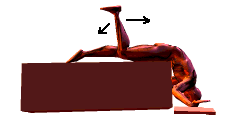Hamstring Injuries
By Mark Jenkins, MD
Editor's Note: Because hamstring injuries are
so common in karate, kung fu and other martial arts we have posted this
article from the SportsMedWeb.
The hamstring muscles are located in the back of the thigh and injuries
can be acute or chronic. Sprinting subjects these muscles to high tension
loads and sudden tears can occur. The recent Olympic games in Atlanta
saw several sprinters go down in agony with acute hamstring injuries.
Conditions that predispose to acute injury are,
• inadequate warm-up/stretching,
• poor lower back flexibility, and
• abnormal biomechanics (e.g., anterior pelvic tilt).
Chronic hamstring injuries usually arise from an improperly rehabilitated
acute injury, but may occur as the result of small amounts of trauma repeated
over a long period (i.e., distance running). Poor hamstring flexibility
increases the likelihood of small tears, which in turn cause the muscle
to shorten and get tighter. A vicious circle can become established. Prompt
and appropriate initial treatment can break this spiral. The initial care
of an acute hamstring injury involves the R.I.C.E. regimen. This acronym
stands for,
• rest,
• ice,
• compression (e.g., an ace bandage), and
• elevation.
 After
1 - 2 days, the athlete can stop the intermittent application of ice and
begin a gentle stretching routine. It is important not to overstretch
into the pain range , since this will contribute to muscle damage. As
recovery progresses, rehabilitation exercises are added and gradually
increased. Soft tissue therapy is useful to promote full range of motion
and to break down areas of "scar" formation. Return to full
functional activity should proceed slowly and be carefully monitored.
Treat the injured muscle with respect. Too quick a return may cause a
quick recurrence. After
1 - 2 days, the athlete can stop the intermittent application of ice and
begin a gentle stretching routine. It is important not to overstretch
into the pain range , since this will contribute to muscle damage. As
recovery progresses, rehabilitation exercises are added and gradually
increased. Soft tissue therapy is useful to promote full range of motion
and to break down areas of "scar" formation. Return to full
functional activity should proceed slowly and be carefully monitored.
Treat the injured muscle with respect. Too quick a return may cause a
quick recurrence.
The final phases of treatment, as well as prevention, involve correcting
any existing biomechanical problems and a hamstring strengthening program.
A good running coach can help uncover any abnormal motion in running and
video analysis can help show the athlete what is happening. Weak abdominal
muscles are often the cause of an anterior (forward) pelvic tilt. Finally,
eccentric exercises are vital for the prevention of hamstring injuries.
 Eccentric
- the muscle lengthens as it exerts force (e.g. lowering a weight). This
can be done with the hamstring by using ankle weights, or using specific
exercise equipment. One method to perform eccentric exercises with hamstring
curl equipment is to raise the weight with two legs, and then slowly lower
with one. Eccentric
- the muscle lengthens as it exerts force (e.g. lowering a weight). This
can be done with the hamstring by using ankle weights, or using specific
exercise equipment. One method to perform eccentric exercises with hamstring
curl equipment is to raise the weight with two legs, and then slowly lower
with one.
This article is posted with permission of Dr. Mark Jenkins and SportsMedWeb.
NOTE: THE MEDICAL INFORMATION PROVIDED IN THIS ARTICLE IS OF A GENERAL
NATURE AND CANNOT BE SUBSTITUTED FOR CARE PROVIDED BY A QUALIFIED HEALTH
PROFESSIONAL. THE CONTAINED INFORMATION DOES NOT ESTABLISH A DOCTOR-PATIENT
RELATIONSHIP, AND FIGHTINGARTS.COM, THE AUTHOR OR RICE UNIVERSITY CANNOT
TAKE RESPONSIBILITY FOR ITS USE, OR MISUSE. EVERY EFFORT HAS BEEN UNDERTAKEN
TO MAINTAIN THE ACCURACY THE INFORMATION CONTAINED WITHIN. HOWEVER, YOU
MUST INDEPENDENTLY VERIFY WHETHER THE MEDICAL INFORMATION IS APPROPRIATE
TO YOU BY CHECKING WITH YOUR DOCTOR.
About The Author:
Dr. Jenkins is Direction of SportsMedWeb. He is a Board Certified medical
practitioner, Director of the Student Health Service at Rice University
and Associate Team physician for Rice University (N.C.A.A. sports).
|